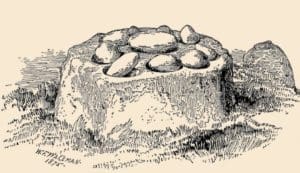The History of Edward II of England

Updated On: April 26, 2024 by Ciaran Connolly
Peeling back the layers of historical figures can often feel a bit like unraveling a complex puzzle, wouldn’t you agree? We’re met with precisely such conundrums when endeavouring to piece together the reign and downfall of Edward II.
This unfortunate monarch is synonymous with one of the most disheartening chapters in English history – filled with desperate struggles for power and riddled with tumultuous relationships that shaped his time on the throne.
Already intrigued, aren’t we? After pouring over volumes of historical accounts, I’ve curated this article to guide you through his life chronicles leading up to a heartbreaking end.
So, grab your proverbial deerstalker cap as we nudge open the creaky doors of medieval times and delve into this mesmerising tale that still subtly reverberates across centuries.

Key Takeaways
- Edward II of England faced numerous challenges during his reign, including tensions with Scotland and France.
- His close companion Piers Gaveston played a significant role in his downfall, causing conflicts with the nobility.
- The war with France and rift with his wife Isabella further contributed to Edward II’s ultimate abdication from the throne.
Early Struggles
Edward II of England faced numerous challenges during his early years, including the influence of his close companion Piers Gaveston and tensions with Lancaster and France.
Birth and childhood
Edward II first saw the world in 1284. His birthplace was Caernarfon Castle in Wales. As the son of Edward I, he had a high rank. He was just a boy when he became the Prince of Wales.
This was a big job for someone so young! But his dad, Edward I, wanted to show that he ruled Wales. That’s why he made his son the Prince of Wales at an early age.
Early campaigns in Scotland
During the early years of Edward II’s reign, he faced numerous challenges, including campaigns in Scotland. As king, Edward sought to assert his authority over the Scottish nobles and bring them under English control.
However, these campaigns proved to be difficult and ultimately ended in failure for Edward.
One notable instance was the Battle of Bannockburn in 1314, where Edward suffered a disastrous defeat at the hands of the Scots under King Robert the Bruce. This defeat weakened Edward’s hold on Scotland and further undermined his credibility as a leader.
Additionally, during this time period, tensions with France also influenced Edward’s military endeavors in Scotland. The French provided support to the Scottish resistance against English rule, which added another layer of complexity to these campaigns.
Influence of Piers Gaveston
Piers Gaveston played a significant role in the reign and downfall of Edward II. He was like a close friend to the king and had his ear on many matters. This caused tensions with the nobility, who felt that Gaveston’s influence over Edward II was too strong.
The barons resented Gaveston’s power and influence, which led to conflicts between them and the king. Eventually, Gaveston was captured by the barons and executed, causing further turmoil in Edward II’s reign.
His relationship with Gaveston is often seen as one of the reasons for his unpopularity among the nobility during his rule.
Tensions with Lancaster and France
During Edward II’s reign, tensions grew with Lancaster and France. The powerful baron, Lancaster, had a long-standing feud with the king. This conflict intensified when Edward II favored his close friend, Piers Gaveston, granting him significant privileges and titles.
This angered Lancaster and other nobles who saw this as favoritism. Moreover, England also faced conflict with France during this time. King Philip IV of France sought to take advantage of Edward’s weaknesses by supporting Lancaster in his opposition against the king.
These tensions further destabilized Edward’s rule and contributed to his ultimate downfall.
Battle of Bannockburn
The Battle of Bannockburn was a significant event during Edward II’s reign. It took place in 1314 between the English and Scottish forces. The Scottish army, led by Robert the Bruce, achieved a decisive victory over the English troops commanded by Edward II.
This defeat was a major blow to Edward II’s ambitions to subjugate Scotland. The battle resulted in heavy casualties for the English and marked a turning point in the Scottish Wars of Independence.
It is remembered as one of Scotland’s greatest military victories and contributed to the overall downfall of Edward II’s reign.
Criticism and famine
During Edward II’s reign, he faced intense criticism and a devastating famine. Many nobles and barons were unhappy with his leadership, citing his limited capabilities as a king. They believed that he lacked the necessary political and military talents to effectively govern England.
This criticism further fueled tensions within the kingdom.
In addition to the harsh criticisms, Edward II also had to cope with a severe famine during his reign. The scarcity of food led to widespread suffering among the people, particularly those in rural areas who relied on agriculture for their livelihoods.
The famine exacerbated existing social and economic inequalities, causing immense hardship for many.

Downfall and Legacy
The downfall of Edward II began with the death of his close companion, Piers Gaveston, which led to the rise of the Despenser family and their influence over the king. This resulted in conflict with France, a rift with his wife Isabella, and ultimately led to his invasion and abdication from the throne.
Edward’s controversial reign continues to leave lasting questions about his capabilities as a ruler and his legacy in English history.
Death of Gaveston
Piers Gaveston, a close friend and favorite of Edward II, met a tragic end during the king’s reign. He faced significant opposition from the barons who resented his influence over the king.
In 1312, Gaveston was captured by powerful nobles and executed without trial. His death deepened the rift between Edward II and the barons, setting in motion a series of events that would ultimately lead to the downfall of the king.
This event marked a turning point in Edward II’s reign and highlighted his inability to maintain control over his kingdom.
Rise of the Despensers
One of the key factors in Edward II’s downfall was the rise of Hugh Despenser and his son, also named Hugh. The elder Despenser became a close advisor to the king and used his influence to accumulate wealth and power.
This caused resentment among the nobility, who saw their own positions threatened. In 1321, a rebellion broke out led by Roger Mortimer and Thomas of Lancaster, with the aim of removing Despenser from power.
However, Edward II managed to suppress the revolt, resulting in Lancaster’s execution and Mortimer’s imprisonment. This only further fueled discontent among the barons. Eventually, Isabella of France – Edward’s wife – formed an alliance with Mortimer against her husband.
Together they invaded England in 1326 and forced Edward II to abdicate in favor of his young son Edward III. The following year, Edward II was imprisoned in Berkeley Castle where he died under mysterious circumstances.
War with France
During my research on the reign of Edward II, I learned about his troubled relationship with France. The war with France was a significant challenge for him during his rule as king.
It began in 1324 when Edward failed to pay homage to Charles IV, the King of France. This led to tensions between the two countries and eventually escalated into full-scale conflict.
The war with France had severe consequences for England. It drained the country’s resources, both financially and militarily. Edward II struggled to finance the war due to economic hardships and a lack of support from his barons.
As a result, he had difficulty raising an army capable of effectively fighting against the French.
Not only was Edward facing challenges at home, but he also faced resistance from within his own family. His wife Isabella formed an alliance with Roger Mortimer in France and invaded England in 1326.
Rift with Isabella
Isabella, the wife of Edward II, played a significant role in his downfall. There was tension between them due to Edward’s close relationship with his favorites, such as Piers Gaveston and later Hugh Despenser.
Isabella felt marginalized and humiliated by these relationships. As a result, she became increasingly resentful towards her husband. This rift between them deepened over time and eventually led to Isabella forming an alliance with opposing factions within England, including Roger Mortimer.
Together, they orchestrated a rebellion against Edward II’s rule and ultimately forced him to abdicate the throne in favor of their son. The rift between Edward II and Isabella marked a pivotal moment in his reign and contributed greatly to his downfall.
Invasion and abdication
After years of conflict and unrest, my reign as king was nearing its end. My inability to assert authority led to a rebellion against me, resulting in an invasion by my own wife, Isabella, and her lover Roger Mortimer.
They successfully captured me and forced my abdication in favor of our son, Edward III. This marked the tragic end of my difficult reign, which had been marred by political intrigue and power struggles with the nobility.
Despite my best efforts, I was unable to hold onto the crown and bring stability to England.
Death and aftermath
After years of political turmoil and military failures, Edward II’s reign came to a tragic end. He was eventually captured in Wales and forced to abdicate the throne in favor of his son.
But that was not the end of his troubles. Edward II met a grisly fate – he was brutally murdered, marking a dark chapter in English history. The aftermath of his death left many questioning the stability and effectiveness of the monarchy.
The controversies surrounding his rule continued to haunt England for years to come, leaving behind a legacy marred by failure and political intrigue.
Controversies and legacy
Edward II’s reign was marked by several controversies and left a lasting legacy on English history. One of the major controversies during his rule was his close relationship with Piers Gaveston, which caused significant tension with the barons and nobility.
Gaveston’s influence over the king led to resentment and criticism from those who believed he was exerting too much power.
Another controversial figure in Edward II’s reign was Hugh Despenser, who rose to prominence after Gaveston’s death. Despenser became the king’s favorite and wielded great influence, provoking further anger among the nobility.
This led to a rebellion against Edward II, fueled by their dissatisfaction with his choice of companions.
In terms of legacy, Edward II is remembered as one of England’s weakest kings. His lack of political and military skills greatly contributed to the downfall of his reign. Additionally, his defeat at the Battle of Bannockburn against Scotland in 1314 remains a humiliating moment for England.
Conclusion
In conclusion, Edward II’s reign was plagued by struggles and missteps. His limited capabilities as a ruler, coupled with political tensions and military failures, ultimately led to his downfall.
Despite the controversies surrounding his reign and its tragic end, Edward II’s legacy serves as a reminder of the complexities and challenges faced by medieval monarchs in England.
FAQs
1. Who was Edward II of England?
Edward II was a king from the royal family in Medieval England. He became the heir and went on to have his coronation as king.
2. How did he become King?
Edward II became the king after a succession where he took over leadership from his father. His coronation marked him as an official member of the royal family’s line of rulers.
3. Did King Edward II rule well?
Many people say that Edward II had limited capability for good rule, leading to subjugation and hard times during his reign in medieval England.
4. What led to the downfall of Edward II?
The downfall of King Edward came when he faced deposition due to poor governance, leading to another succession within the royal family’s lineage.






